For the past few years, it seems that charcuterie boards of all types have had a grip on the events world, mostly for the better. What started as an elaborate snacking trend has taken several turns—cheese and crackers have been swapped for bread and butter, brunch boards have evolved into specialty waffle boards—until the grazing board reached its most recent development: the grazing table, an opulent display of maximalism that can be adapted to match any celebratory setting.
This trend doesn’t seem to be fading anytime soon, so it’s time to make sure you’re set up for success. “Regardless of how you may approach grazing tables, it’s an enduring trend that caterers must get on board with sooner rather than later,” stated an article from Catersource. Whether your client wants a simple cured meat and cheese board or a luxurious table overflowing with a variety of seafood items, there’s more to this trend than picking a theme. Here are a few things you need to know.
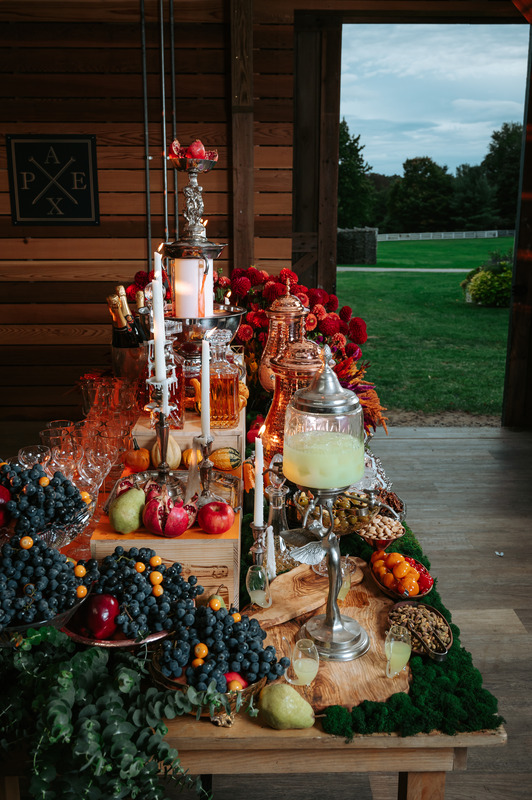
Food and decor displayed at varying heights creates a more stimulating image for the eye. Table by and photo courtesy Edenopolis
Grazing habits
There are many reasons why grazing boards and tables have become an event go-to. For starters, in recent years, event design has tended toward maximalism, providing a stimulating vision for both in-person attendees and those viewing photos and videos of the event on social media. Elaborate grazing tables with unique ingredients and interactive displays bode well for both in-person experiences and online scrolling—and in both cases, this creative array of food is a great reflection of your expertise as an event pro.
Grazing boards and tables offer flexibility and room for personalization, a prevailing trend in 2024 (and the predictable future). Clients want every aspect to be an expression of their unique personalities, and grazing tables allow for a curation of food that both fits the client’s tastes and leaves room for a variety of guest preferences.
“Grazing boards are definitely a huge trend right now because they're a lot easier to customize than plated dinners,” Danielle Minninger, the Marketing Director of Le Meridien St Louis Clayton, told Special Events. “Couples don't have to worry about selecting one entrée to make everyone happy.”
Grazing boards and tables also encourage conversation among guests, creating a casual, social atmosphere. This conversation is elevated even more when interactive chef stations and service are provided.
In an article for BizBash, Kabrel Geller, owner of This Messy Table LA, said that grazing tables are more than a vehicle for serving food—they also act as an art installation and interactive food experience, which increases attendee engagement. “I've found that when This Messy Table is the mainstage food at parties, those parties usually last an hour or two longer than they normally would,” Geller said. “More people tend to be more comfortable in taking how much they want [with a grazing table], whereas when you're doing passed hors d'oeuvres, they can feel stuffy and old school. People might not like to eat as much, even if they want to.”
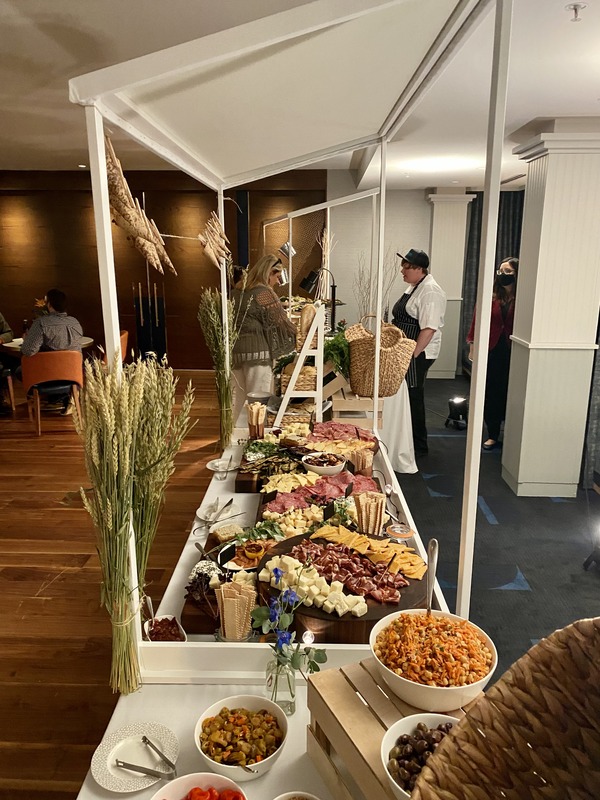
A grazing table created by placing charcuterie boards together across a table, with an attendant to oversee guests. Table by and photo courtesy Le Meridien St. Louis Clayton
Bountiful offerings
Besides the typical charcuterie spread—with preserved meats, a variety of cheeses, and some assortment of bread, crackers, fruit, pickles, spreads, and nuts—there's been a surge of creative board alternatives with untraditional ingredients. Catersource + The Special Event 2022 turned attention to French fry boards, dessert boards, brunch boards, veggie boards, and even a dessert board.
Burrata boards, hummus or polenta boards, and seafood displays are trending. A new take on this trend is popping up in the form of caviar displays (turn to page 34 in the adjoining Catersource issue for more on caviar). All types of bread and brunch boards are popular as well.
Other spreads we’ve seen pop up:
- Candy table
- Pickle board
- Antipasti board
- BBQ table
- Holiday themes
- Tropical theme
- Cultural/regional spreads (Mediterranean,
- South Asian, etc.)
- Hot cocoa boards
- Taco table
- Mezze table
- Seafood/coastal table
Le Meridien St. Louis Clayton has added European-inspired spreads to their offerings, including a Mediterranean Grazing Table topped with marinated artichoke hearts, fresh mozzarella, feta, grilled halloumi, and more, as well as a French Bistro Table topped with warmed brie, fruit and nut chutney, and prosciutto.
“When it comes to selecting a grazing board, one of the biggest trends I've been seeing is couples wanting custom offerings with a super personalized touch,” continues Minninger. “For example, if a groom is from Chicago and a bride is from St. Louis, we could create a board inspired by dishes from each city, like mini Chicago hot dogs and toasted ravioli (which is a St. Louis thing!). We can also create a board that incorporates a family recipe like ‘Grandma's macaroni’ for a custom mac ‘n cheese board that comes with different types of pasta and toppings. We love giving couples the opportunity to add something extra meaningful to the meal on their big day!”
These spreads will sometimes make up an entire meal. “Grazing boards are no longer limited to hors d'oeuvres,” says Minninger. “They can be used to serve dessert or even a full meal! Over-the-top presentation and displays are key when it comes to serving dinner on a board, which is much different from the sleek individual portions that used to be popular.”
Chef Richard Vanderplas, owner of Edenopolis, offers what he calls “feasting tables” and says that when it comes to being creative, nothing is off the table (pun fully intended). When asked what food can be displayed, he told Special Events, “Everything. There are no limits. You can have metal platters with chilled items on ice, electric warmers or Sterno® heating beautiful silver platters, chefs carving whole roasts of meat, and anything else you can imagine.”
The grazing table is a place for creativity to thrive. “The only rule here is that it is one huge table, filled to the brim with food, that makes your guests feel like little kids with joy when they walk up to it,” says Vanderplas.
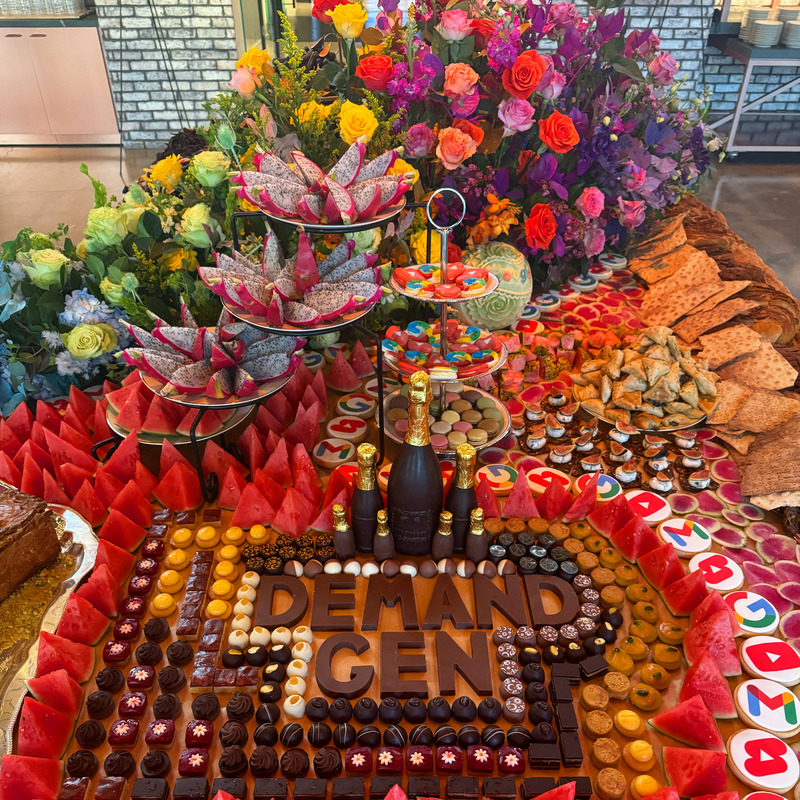
Grazing tables are a great way to incorporate a client’s brand throughout the feasting experience. Table by and photo courtesy Edenopolis
Getting started
There is no shortage of logistics to consider when incorporating a grazing board or table into your event. Here are some things to keep in mind.
Keep it fresh
You don’t want a photo snapped halfway through the event with part of the grazing table eaten away. It’s important to keep the table staffed with attendants who can replenish the food and keep the area tidy. Make sure you know who is responsible for this and how often they need to refresh the spread.
“You should always have someone physically there cleaning up the table as guests eat [from] it, explaining things, making plates, and picking food up off the floor,” says Vanderplas. (More on that in a bit.)
The right environment
When having food displayed out in the open, it’s always important to know and abide by federal and state food safety laws. You’ll also want to pay attention to the weather and environmental conditions of the event space and adjust the menu accordingly.
“Being aware of the temperature and the placement of each grazing table, especially if it's outdoors, is also important,” says Minninger. “Certain foods may spoil quickly, and others could attract insects.”
Vanderplas agrees. “Make sure you select the correct foods that do well in hot outdoor conditions. Do not use cut fruits, but instead use grapes; do not use brie, but instead Parmesan; do not use chocolate, but instead mini brownies,” he recommends.
“Make sure to be good at saying ‘no’ to your client; remember, they are not experts on food safety! If you educate them on why you can't have seafood sitting on an outdoor table in July, they will understand. Also, a non-negotiable, regardless of the weather, time of year, or type of food: always protect your food from the sun with an umbrella or tent. I also always have ‘fly helicopters’ on the table over dips and sweets.”
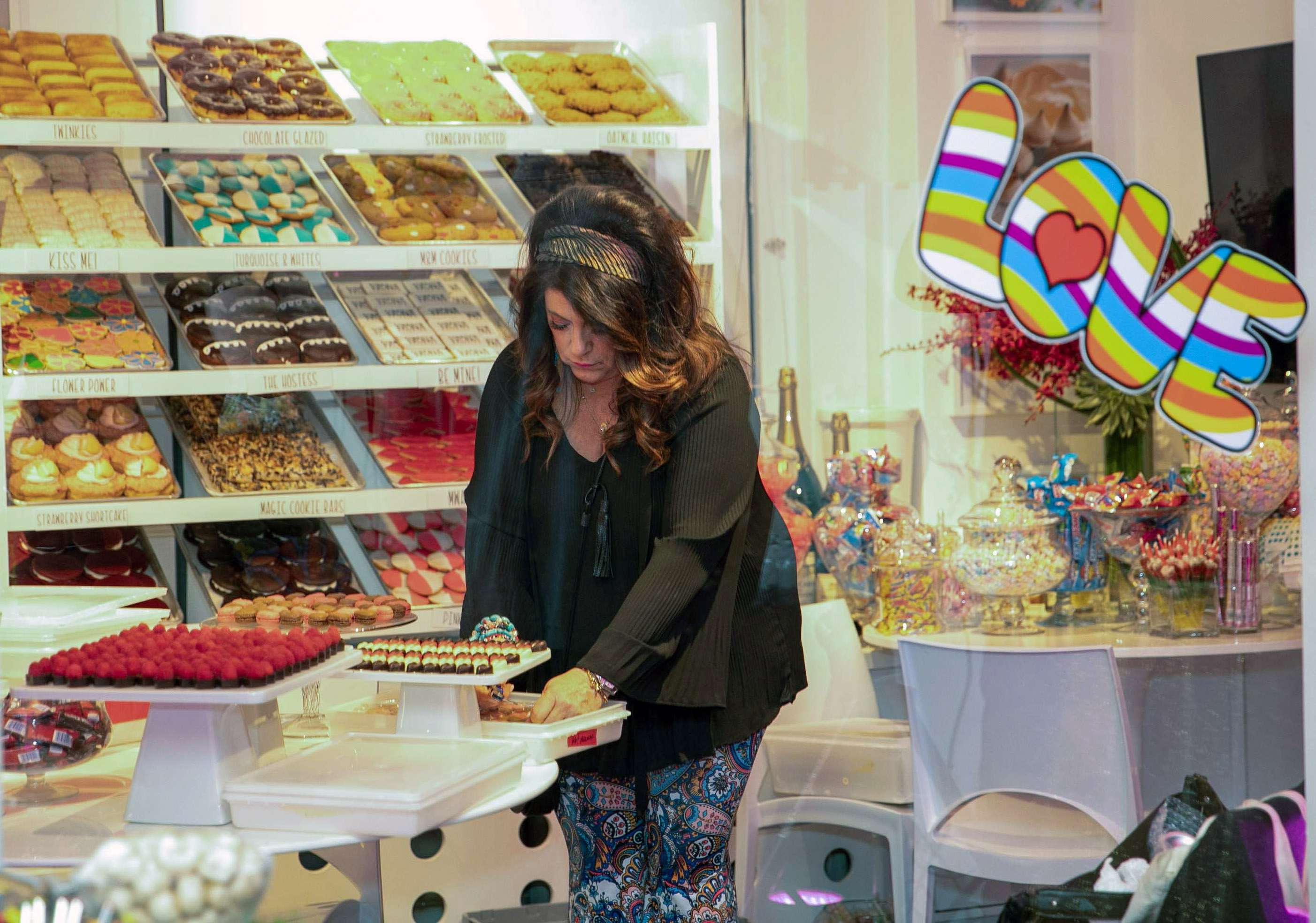
Chef Robin Selden of Marcia Selden Catering & Events sets up a Grazing Room pre-event: a small office turned into a wonderland filled with candy, cookies, and other sweets, as well as “to go” boxes for guests to fill up with their favorites before departing the event. Photo coutesy Marcia Selden Catering & Events
Handling different diets
The beauty of grazing boards and tables is that guests can choose what they like, making it easier to cater to individual preferences—and to dietary restrictions. Per usual, it’s important to have guests notify you of any allergies and restrictions before the event, so the caterer can separate food or leave it off the table.
“If there are allergies that are not so serious, make sure your staff are aware of what is what, and can answer questions for the guests,” says Vanderplas. “It is important that your staff are properly trained to answer these questions.”
Signage can take on various forms, though Vanderplas prefers to ditch the signage in favor of educated attendants.
“I am not a fan of signage; I think it's ugly. In general, it takes away from the art of your table. In the event that you have a grazing table that is completely unattended by staff, and no one is there to explain, then signage can be helpful.”
Geller is of the same mindset. “If an event is more than 50 people, it really behooves the host and the guests to have an attendant there,” she says. “Because people have questions, and they want to know, ‘How did this happen? And how did you do it? And what's that? And that?’ So, I have found that [an attendant] can be really important to the success of how the event goes.”
Vanderplas advises having one staff member per 20 guests. This means one head chef per food type/service, one to four assistants per station, and can depend on the amount of food per menu, not just the guest count.
One option for signage is to put the printed (or digital) menu near the table to avoid clutter.
If you don’t have attendants, Minninger recommends all garnishes and enhancements be edible to ensure guest safety.
Design
When it comes to the table, you could use ornately carved handiwork, but you can also use a few plastic tables pushed together with tablecloths and butcher paper over the top. You can even use parts of the venue, like cutouts and thick windowsills, for extra inventive uses of space.
A physical or video walkthrough of the venue is a good start for creating the table design. “This is important as you can get an idea of what you are walking into. Every venue has its unique challenges,” suggests Vanderplas. “Make sure you know if the building has a service entrance/loading dock and how it works, and [that] you have all the appropriate insurance and COIs (Certificate of Insurance) with the building handled ahead of time.”
You may have a design in mind for decorating the table, but if the caterer has a preferred layout, give them the reins to bring their vision to life in a way that works with food service. That being said, there are several ways to display and decorate food tables that can make them feel like an art installation at your event.
“I love making a huge floral foam installation of flowers right in the center of the table,” says Vanderplas, “and tapering it down to the edges of the table with various risers. I like wood, because it is natural looking, hides grease, and is tough and light for transport. It's good to put brown wax paper down on the display pieces to keep them clean.”
The best grazing table designs have no negative space, filling the entirety of the tabletop and even overflowing off the edges. Various heights with risers and decor will be interesting to the eye and incorporating seasonal ingredients and dried herbs into the display will give it that extra zhuzh.
In the article for BizBash, Hailey Keane of Graze & Co. said that she always tries “to make it feel like a Renaissance painting, still life kind of setup, so it doesn't feel like it's just thrown together.”
Remember, this is the place to embrace maximalism and let art take the forefront!
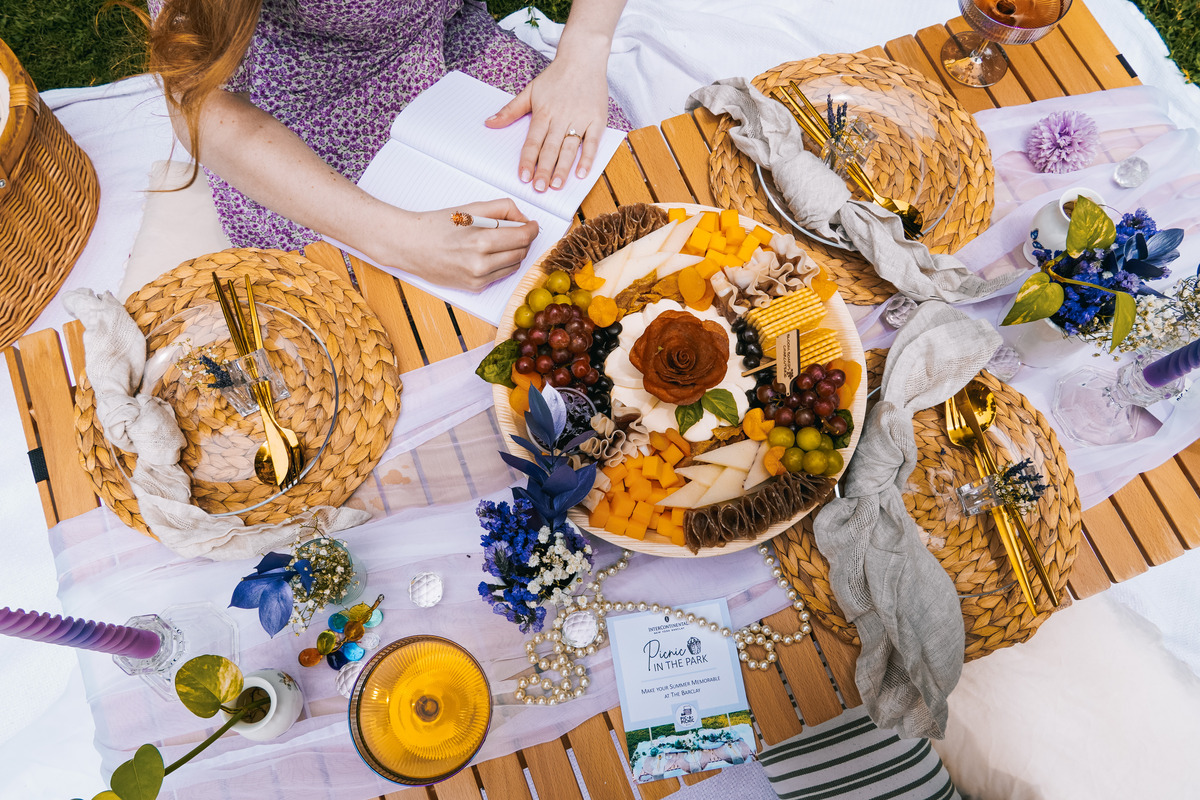
Of course, a classic charcuterie board will always stay classy, like this board served at a picnic by InterContinental New York Barclay, paired with Veuve Clicquot champagne. Photo courtesy Eleven Six PR
Sustainability
One thing to get ahead of with grazing tables is food waste. It’s imperative to work with a caterer who values sustainability, so that you can avoid serving excess food and have a plan for using the leftovers.
“This all starts with a talk with the client,” says Vanderplas. “Some clients want to keep all the food for a party the next day, some want it to be donated. We have connections to homeless shelters, firehouses (with lots of hungry firefighters), and lots of hungry staff! We always bring Ziplock bags and aluminum trays to pack up leftovers. We hate throwing food away!”
The key to avoiding waste is to communicate thoroughly with both the client and the caterer ahead of time. Vanderplas recommends aiming for only 10% more food than can be consumed. He sticks with two to four ounces of charcuterie per person and one ounce of fruits and veggies per person.
By communicating well and sticking with a precise plan, you should be able to have an opulent display that doesn’t end up in the trash after the event.
Working with a caterer
Of course, the real key to successful grazing boards and tables is close collaboration with the caterer. Make sure the caterer is willing to work with you in a way that aligns with the rest of the event.
“Collaboration with the host or the event planner is really important to me,” says Geller, “because we add these floral elements, and [the planner] probably has a florist that they're working with.... For me, that collaboration is super important to the success and look of the table.”
Vanderplas also insists on respectful collaboration with the caterer. “Get everything in writing,” he suggests. “Planners should be in charge of all logistical details, ordering of rentals, staffing, and design. Once that has been communicated in writing, and confirmed by the caterer, please let us do our job and trust us to do it well.”
By clearly communicating and putting in writing who is responsible for what, you can ensure a healthy relationship with your caterer and a smooth event that lets each of you excel at what you do best.
Grazing tables are a chance to get creative, elevating your event theme and wowing guests with photo ops and interactive chef stations. Use this trend to enhance the guest experience and show off your expertise.
As chef Thomas Keller once said, “Food should be fun.” This trend will be around for awhile, so have fun with it!





